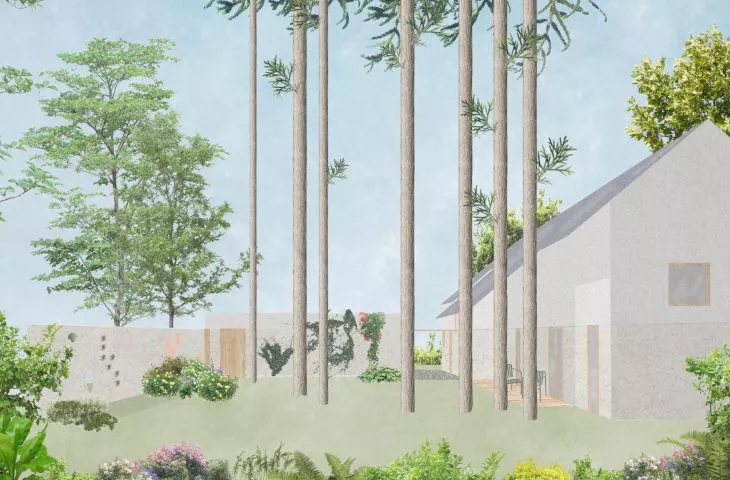Modest and simple, finished with traditional plasterwork, the body of the single-family house in Wilcza Gora, near Warsaw, is sunk in the forest surroundings, provides space for a wild garden and somewhat hides behind a mysterious plastic wall - an irregular wall built from the residents' memories.
The single-family house near Warsaw, located near the wooded area of Magdalenka, was designed by architects from the Zmrok design group. The development consists of two blocks on a rectangular plan - the longer one, located in the northern part of the plot, houses a two-story house, and a smaller one, on the street side, in which a two-car garage with space for tinkering was located. Parallel to the house was placed the aforementioned plastic wall, which encloses the plot from the side where the neighbors live.



axonometry
© Dusk
The first floor of the house is occupied by a spacious, open-plan living area - a living room with a kitchenette, an area for working from home and a private area in the east wing with a bedroom and a large bathroom. Upstairs there are two additional bedrooms and a bathroom.
Ola Kloc: What was the priority for the investors?
Zuza Sprogis: The priority for the investors was to create a safe space that provides privacy and intimacy.
The 


situation
© Zmrok
Ola: You varied the simple body of the house on a rectangular plan, covered with a gable roof with decorative plasters, where did you get the idea for such a solution and what effect is it supposed to have?
Zuza: We wanted the massing to be as simple as possible, and we also wanted aesthetic, durable and economical material solutions. Traditional plasters offer the possibility of very different visual effects only depending on how they are grained and made. This is a method that has been used for a very long time, which stands up well to the passage of time, and this is very important to us.
Ola: The plot will be separated from one side by a plastic wall - a "wall of memories". Tell us, please, more about this idea.
Zuza: The wall provides a sense of enclosure, which was sought by investors. In addition, it separates the wild garden zone, which is a refuge for insects and smaller animals, from the manicured recreational greenery. We want it to be an element that will evolve with the residents and become a carrier of memories and good associations. A tile brought back from a trip, a child's handprint or a pebble found during a walk can be placed on it.



cross section
© Dusk
Ola: What was the most difficult part of this project, and what are you most satisfied with?
Zuza: The most difficult thing, in my opinion, was to provide a sense of privacy due to the neighboring dense buildings. Construction is still underway, but we hope that we were able to design a building that meets the investor's expectations. It is very important to us that the people who will live in the buildings we design feel that they are made especially for them. We are also pleased that the house will be built in a sustainable way, with ecological solutions in mind.



longitudinal cross-section
© Zmrok
Ola: What eco-friendly solutions did you include in the design?
Kasia Królak: We considered ecological issues on two levels - by referring to forms of traditional construction and using technologies such as recuperation and photovoltaics. We tried to preserve the maximum number of existing trees on the plot, and the garden designer, Agata Milanowska, proposed a rain garden and plant species that will, along with the existing trees, shelter small animals and support pollinators. The arcade, designed on the south side, protects the interior of the house from overheating in summer, while in winter it allows the low rays of the sun to penetrate it. All of the building envelope has increased heat transfer parameters, and the use of a single-layer wall reduces resources and garbage. What's more, the selected materials are durable and do not require cyclic refreshing every dozen years or so.
Ola: Thank you for the interview.





























